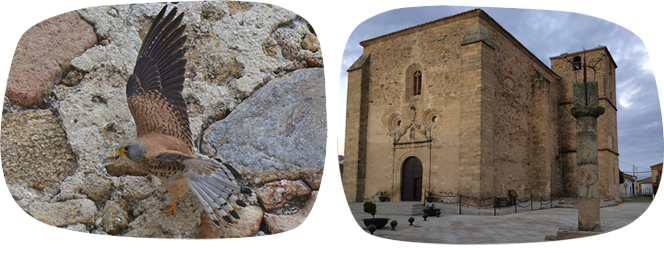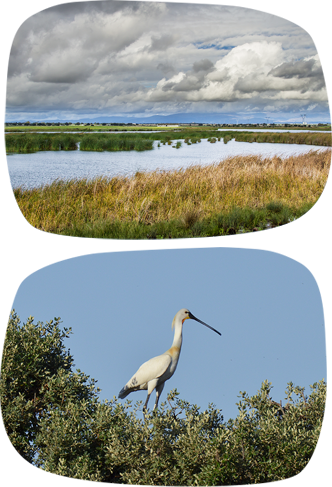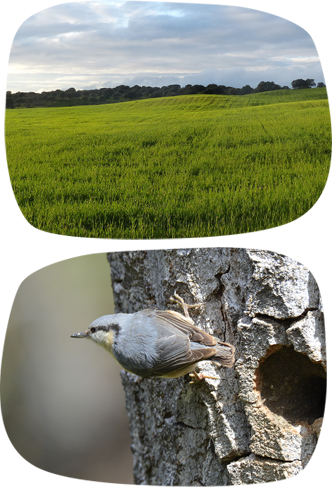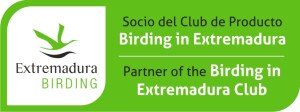Three areas designated Special Protection Areas for Birds (SPAs) converge in Saucedilla:
-
LESSER KESTREL BREEDING COLONY SPA
A breeding population of 15 – 20 pairs (depending on the year) of Lesser Kestrels (Falco naumanni) make use of the various holes in the walls of the San Juan Bautista church to breed, leading to its designation as the “Saucedilla Lesser Kestrel breeding colonies” SPA.
This is a small insectivorous falcon species, closely tied to urban and humanised habitats. Essentially Mediterranean in distribution in Europe. It seeks areas of warm and dry climates to breed, with open ecosystems where it can search for areas of high prey abundance (crickets, beetles, grasshoppers, etc.).
Present in the breeding areas from the beginning of March [no febrero en el N de Ex] to the end of July, clutches are started in April and fledglings begin to fly from the end of June. After breeding it vacates the breeding areas and returns to Africa (Senegal, Mauritania and other countries in the centre and east).

-
ARROCAMPO SPA

Declared a special Protection Area for birds. The Arrocampo reservoir is the best single site to see water birds in Extremadura. The largest, and sometimes only breeding populations of diverse species in the region occur here. These include Purple Swamphen (Porphyrio porphyrio), Purple Heron (Ardea purpurea), Squacco Heron (Ardeola ralloides), Great Bittern (Botaurus stellaris), Savi’s Warbler (Locustella luscinioides) and Bearded Reedling (Panurus biarmicus).
In addition, the presence here of other species more typical of coastal saltmarshes and wetlands is notable, such as Eurasian Spoonbill (Platalea leucorodia), Glossy Ibis (Plegadis falcinellus), Great Egret (Ardea alba) or Osprey (Pandion haliaetus).
The diversity of species increases during the migration periods with the appearance of Bluethroat (Luscinia svecica), which is also present in winter, Sedge Warbler (Acrocephalus schoenobaenus) and Baillon’s, Little and Spotted Crakes (Porzana parva, P. pusilla, P. porzana).
The best represented group amongst them all are the herons and egrets, plus rallids, (Swamphen, crakes, Water Rail, Common Moorhen, Eurasian Coot). Amongst the ducks, the commonest are Mallard (Anas platyrhynchos) and Gadwall (Anas strepera). Great Cormorants (Phalacrocorax carbo) are abundant, as are Little Grebes (Tachybaptus ruficollis) and Great Crested Grebes (Podiceps cristatus).
Other species of particular interest which almost guarantee observation are Western Marsh Harrier (Circus aeruginosus), Eurasian Penduline Tit (Remiz pendulinus), Gull-billed Tern (Gelochelidon nilotica) and Common reed Bunting (Emberiza schoeniclus).
-
MONFRAGÜE SPA & SURROUNDING SPA

Saucedilla is partially intergrated into the Monfragüe National Park Zone of Influence, the “Monfragüe and surrounding dehesas” SPA, the Monfragüe Biosphere reserve and the Area of Special Conservation. In combination they highlight the high value of dehesa as an ecosystem, promoting its protection and recognition of these values.
This ecosystem is represented in the eastern sector of the municipality, being principally open in character, with medium sized Western Holm Oaks predominating, intermixed with patches of scrub. Indeed Saucedilla coincides with the north-eastern limit of this formation, it can be considered an ecotone, where two landscapes types converge: the dehesa and the wetland and where, by definition, the maximum interaction between the two bordering ecosystems occurs.
The most emblematic species of Monfragüe hunt over this area, such as Egyptian Vulture (Neophron percnopterus), Eurasian Black Vulture (Aegypius monachus), Bonelli’s Eagle (Aquila fasciata), Spanish Imperial Eagle (Aquila adalberti) and Red Kite (Milvus milvus), given the significant food resources available.
A number of other species are intimately tied to the ecosystem, including Iberian Green Woodpecker (Picus sharpei), Iberian Magpie (Cyanopica cooki), Eurasian Jay (Garrulus glandarius), Eurasian Nuthatch (Sitta europaea) and Common Woodpigeon (Columba palumbus).
Another important group of small passerines can be seen as they move nervously through the scrub, such as Common Chaffinch (Fringilla coelebs), Woodchat & Southern Grey Shrikes (Lanius senator & L. meridionalis), Spotted Flycatcher (Muscicapa striata), Thekla Lark (Galerida theklae), Rock Bunting (Emberiza cia), Eurasian Linnet (Carduelis cannabina), Blackcap (Sylvia atricapilla) and Garden Warbler (Sylvia borin). [Ésta ultima es migrante solo]
Other important species which can be seen in the Saucedilla dehesas are Common Cranes (Grus grus) and the scarce Black-winged Kite (Elanus caeruleus), which reaches one of its highest regional densities here.

